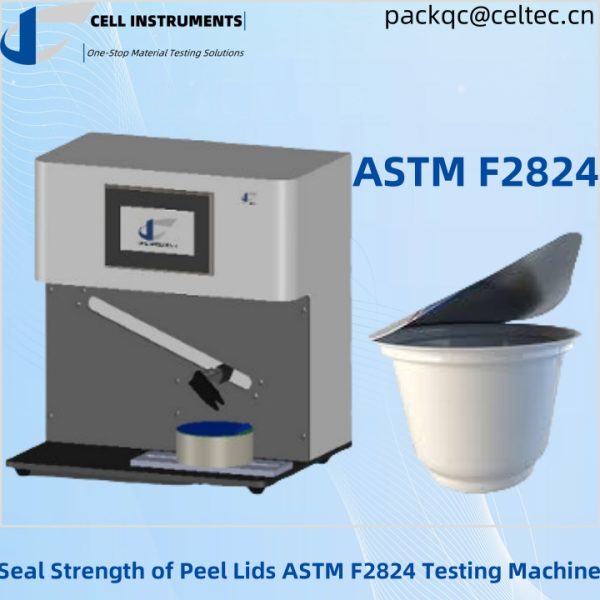How to Test Seal Strength of Peel Lids According to ASTM F2824 and ISO 17480 Standards
Ensuring the integrity and safety of sealed packaging is critical across various industries, including food, medical, and pharmaceuticals. The seal strength of peel lids is a key factor in maintaining product quality and preventing contamination. In this article, we will explore how to test the seal strength of peel lids according to ASTM F2824 and ISO 17480 standards.
I. Understanding Seal Strength of Peel Lids
The seal strength of peel lids refers to the force required to peel or separate the lid from its container. This parameter is crucial in assessing the packaging’s ability to protect its contents effectively. Inadequate seal strength can lead to leaks, contamination, and compromised product integrity.
ASTM F2824 and ISO 17480 Standards
To standardize the testing process, ASTM F2824 and ISO 17480 provide detailed procedures and requirements. These standards ensure consistency, reliability, and comparability of test results across different testing scenarios.
II. ASTM F2824 Standard
1. Purpose and Scope
The ASTM F2824 standard, titled “Standard Test Method for Mechanical Seal Strength Testing for Round Cups and Bowl Containers with Flexible Peelable Lids,” outlines specific procedures for measuring the mechanical seal strength of round cups and bowl containers with flexible peelable lids. This standard aims to provide a consistent method for assessing seal strength, ensuring reliability and reproducibility.
2. Test Methods and Procedures
Calibration and Setup
- Calibration: Ensure the force-measuring device is calibrated to maintain accuracy.
- Setup: Secure the container and lid in the test equipment fixture, aligning the peel line with the direction of the test.
Conducting the Test
- Attach the Lid: Secure the lid’s peeling tab to the grip of the force-measuring device.
- Set the Peel Rate: Adjust the peel rate to 12 ± 0.5 in./min (300 ± 12.7 mm/min).
- Initiate the Test: Begin the test and record the force required to peel the lid.
Interpreting Results
Analyze the data focusing on maximum, minimum, and average forces. Compare the results with industry standards to determine compliance.
III. ISO 17480 Standard
1. Purpose and Scope
The ISO 17480 standard, “Packaging — Accessible Design — Ease of Opening,” complements ASTM F2824 by providing guidelines for the ease of opening of packaging. This standard emphasizes user-friendliness and accessibility, ensuring that packaging can be easily opened by consumers, including those with limited dexterity.
2. Test Methods and Procedures
Calibration and Setup
- Calibration: Confirm the calibration of the testing device to ensure accurate measurements.
- Setup: Properly secure the container and lid in the testing apparatus.
Conducting the Test
- Attach the Lid: Connect the lid’s peeling tab to the testing device.
- Set the Parameters: Adjust the testing parameters according to ISO 17480 guidelines.
- Initiate the Test: Conduct the test and record the force required to peel the lid.
Interpreting Results
Evaluate the results based on maximum, minimum, and average forces. Ensure the packaging meets the ease of opening requirements specified in ISO 17480.
IV. Testing Equipment: Cell Instruments CCPT-01 Container Lids Peel Tester
To accurately measure the seal strength of peel lids, specialized testing equipment is required. The Cell Instruments CCPT-01 Container Lids Peel Tester is an advanced instrument designed for this purpose.
1. Key Features and Benefits
- High Precision and Accuracy: The tester features an internal three-pillar structure, a stepping motor, and a precision ball screw, ensuring high precision and accurate measurements.
- User-Friendly Interface: Equipped with a PLC (Programmable Logic Controller) and an HMI (Human-Machine Interface) color touchscreen, the instrument is easy to operate.
- Customizable Test Parameters: The instrument allows stepless speed regulation and offers both manual and automatic test initiation.
- Overload and Stroke Protection: Ensures the safety and longevity of the instrument by preventing damage due to excessive force or movement.
- Automated Data Recording and Analysis: Real-time force curve display and automated calculation of maximum, minimum, and average forces enhance efficiency and accuracy.
2. Applications
The CCPT-01 Container Lids Peel Tester is versatile and can be applied across various industries:
- Packaging Industry: Ensures the integrity of sealed packages, preventing leaks and contamination.
- Food Industry: Verifies the seal strength of food containers, maintaining freshness and preventing spoilage.
- Medical and Pharmaceutical Industries: Tests the seal strength of medical packaging to ensure sterility and safety.
FAQ
Testing the seal strength of peel lids is crucial to ensure that the packaging maintains its integrity and prevents contamination. It helps in verifying that the packaging can protect its contents effectively.
The CCPT-01 features an internal three-pillar structure, a stepping motor, and a precision ball screw, which ensure high precision and accurate measurements.
The key standards for testing the seal strength of peel lids are ASTM F2824 and ISO 17480. These standards provide detailed procedures and requirements for consistent and reliable testing.
Yes, the CCPT-01 can be customized to meet specific testing requirements, including adapting the tester for different container shapes, sizes, and materials.
Compliance with these standards ensures that the testing methods meet industry standards, enhancing credibility and reliability. It helps in maintaining product quality and meeting regulatory requirements.
Testing the seal strength of peel lids is essential for maintaining product quality and safety across various industries. By adhering to ASTM F2824 and ISO 17480 standards, manufacturers can ensure consistent and reliable results. The Cell Instruments CCPT-01 Container Lids Peel Tester offers advanced features and high precision, making it an ideal choice for seal strength testing.

